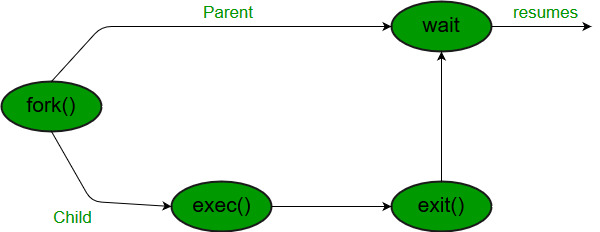先决条件: 货叉系统调用
对wait()的调用将阻止调用进程, 直到其子进程之一退出或接收到信号为止。子进程终止后, 父进程
继续
等待系统调用指令后执行。
子进程可能由于以下原因而终止:
- 它调用exit();
- 它从main返回(int)
- 它从操作系统或其他进程接收信号, 其默认操作是终止。

C语言语法:
#include
#include
// take one argument status and returns
// a process ID of dead children.
pid_t wait(int *stat_loc);如果任何进程具有多个子进程, 则在调用wait()之后, 如果没有子进程终止, 则父进程必须处于等待状态。
如果只有一个子进程终止, 则返回一个wait()返回终止的子进程的进程ID。
如果终止了多个子进程, 则比wait()收获任何子进程
随便的孩子
并返回该子进程的进程ID。
当wait()返回时, 它们还定义
退出状态
(告诉我们, 一个进程为什么终止), 如果没有, 则通过指针
null
.
如果任何进程没有子进程, 则wait()立即返回" -1"。
注意:"由于环境问题, 此代码无法在简单的IDE中运行, 因此请使用终端来运行代码"
例子:
// C program to demonstrate working of wait()
#include<stdio.h>
#include<stdlib.h>
#include<sys/wait.h>
#include<unistd.h>
int main()
{
pid_t cpid;
if (fork()== 0)
exit (0); /* terminate child */
else
cpid = wait(NULL); /* reaping parent */
printf ( "Parent pid = %d\n" , getpid());
printf ( "Child pid = %d\n" , cpid);
return 0;
}输出如下:
Parent pid = 12345678
Child pid = 89546848// C program to demonstrate working of wait()
#include<stdio.h>
#include<sys/wait.h>
#include<unistd.h>
int main()
{
if (fork()== 0)
printf ( "HC: hello from child\n" );
else
{
printf ( "HP: hello from parent\n" );
wait(NULL);
printf ( "CT: child has terminated\n" );
}
printf ( "Bye\n" );
return 0;
}输出:取决于环境
HC: hello from child
Bye
HP: hello from parent
CT: child has terminated
(or)
HP: hello from parent
HC: hello from child
CT: child has terminated // this sentence does
// not print before HC
// because of wait.
Bye子状态信息:
通过等待报告的关于孩子的状态信息不仅是孩子的退出状态, 还包括
- 正常/异常终止
- 终止原因
- 退出状态
要查找有关状态的信息, 我们使用
WIF
…。宏
1.
WIFEXITED(状态)
:孩子正常退出
•
WEXITSTATUS(状态)
:孩子退出时返回代码
2.
WIFSIGNALED(状态)
:孩子退出, 因为未捕获到信号
•
WTERMSIG(状态)
:给出终止信号的编号
3.
WIFSTOPPED(状态)
:孩子停止了
•
WSTOPSIG(状态)
:给出停止信号的编号
/*if we want to prints information about a signal */
void psignal(unsigned sig, const char *s);例子:
检查以下程序的输出。
// C program to demonstrate working of status
// from wait.
#include<stdio.h>
#include<stdlib.h>
#include<sys/wait.h>
#include<unistd.h>
void waitexample()
{
int stat;
// This status 1 is reported by WEXITSTATUS
if (fork() == 0)
exit (1);
else
wait(&stat);
if (WIFEXITED(stat))
printf ( "Exit status: %d\n" , WEXITSTATUS(stat));
else if (WIFSIGNALED(stat))
psignal(WTERMSIG(stat), "Exit signal" );
}
// Driver code
int main()
{
waitexample();
return 0;
}输出如下:
Exit status: 1我们知道如果终止了多个子进程, 那么wait()会获得任意子进程, 但是如果我们想获得任何特定的子进程, 我们将使用waitpid()功能。
C语言语法:pid_t waitpid(child_pid, &status, 选项);
选项参数
- 如果为0表示没有选项, 则父级不必等待终止子级。
- If万航表示如果子项未终止则父项不等待, 只需检查并返回waitpid()。(不阻止父级进程)
- 如果child_pid是-1那么意味着随便的孩子, 这里的waitpid()工作与wait()工作相同。
waitpid()的返回值
- 孩子的pid(如果孩子退出了)
- 0, 如果使用WNOHANG并且未退出孩子
// C program to demonstrate waitpid()
#include<stdio.h>
#include<stdlib.h>
#include<sys/wait.h>
#include<unistd.h>
void waitexample()
{
int i, stat;
pid_t pid[5];
for (i=0; i<5; i++)
{
if ((pid[i] = fork()) == 0)
{
sleep(1);
exit (100 + i);
}
}
// Using waitpid() and printing exit status
// of children.
for (i=0; i<5; i++)
{
pid_t cpid = waitpid(pid[i], &stat, 0);
if (WIFEXITED(stat))
printf ( "Child %d terminated with status: %d\n" , cpid, WEXITSTATUS(stat));
}
}
// Driver code
int main()
{
waitexample();
return 0;
}输出如下:
Child 50 terminated with status: 100
Child 51 terminated with status: 101
Child 52 terminated with status: 102
Child 53 terminated with status: 103
Child 54 terminated with status: 104这里, Children pids取决于系统, 但是为了打印所有的孩子信息。
如果发现任何不正确的地方, 或者想分享有关上述主题的更多信息, 请写评论。

